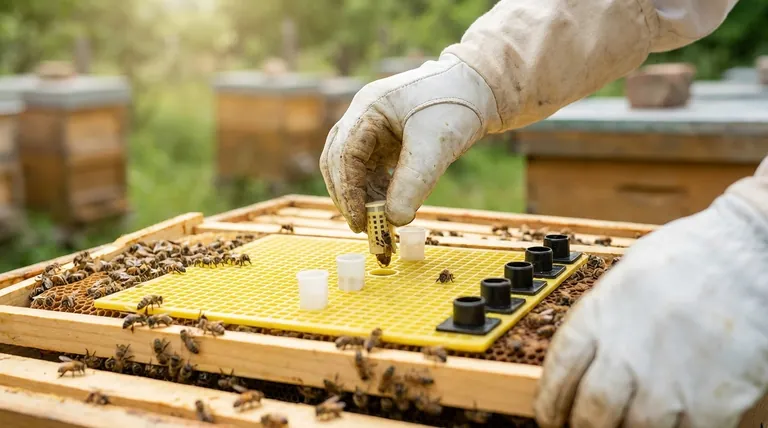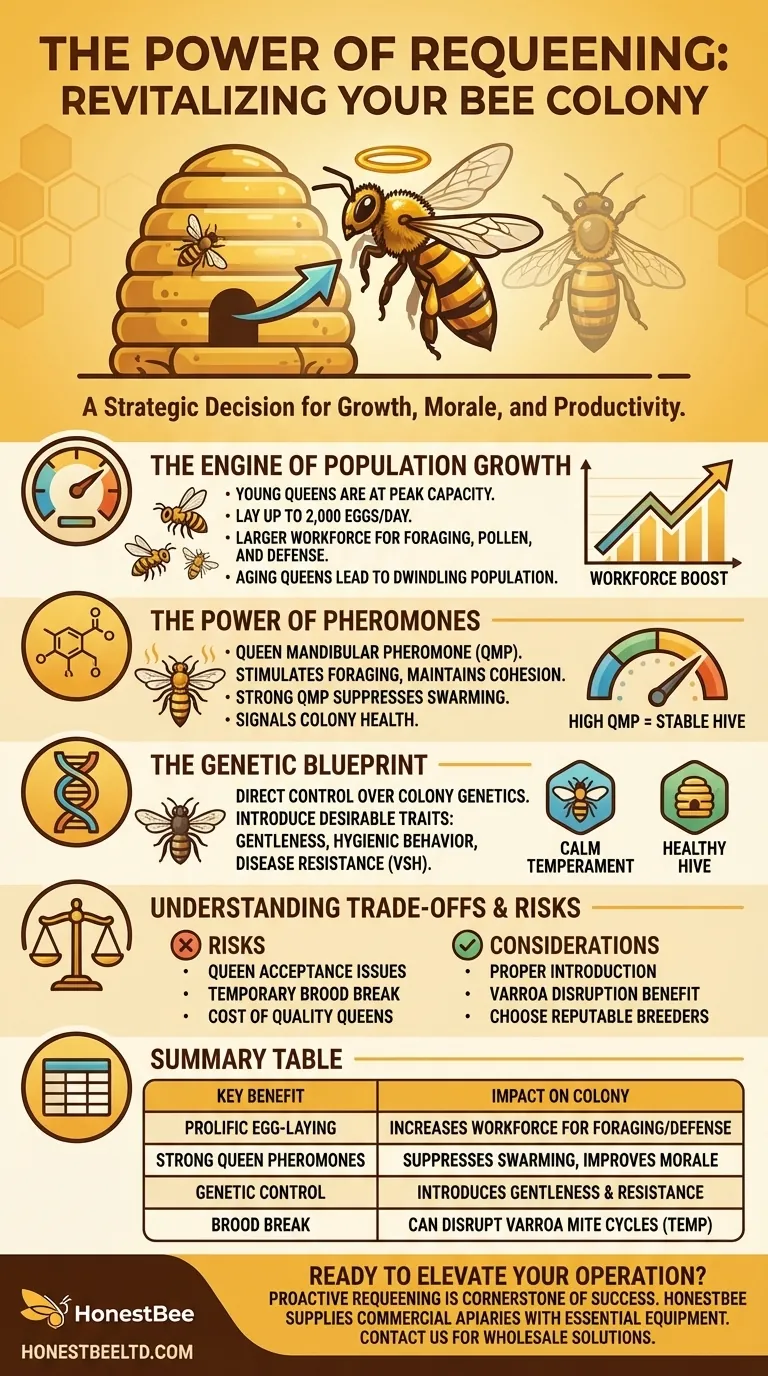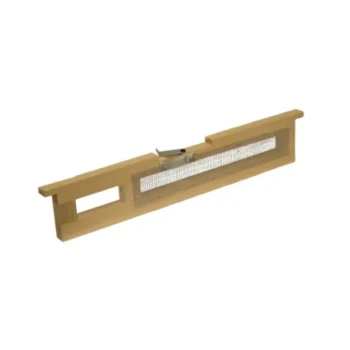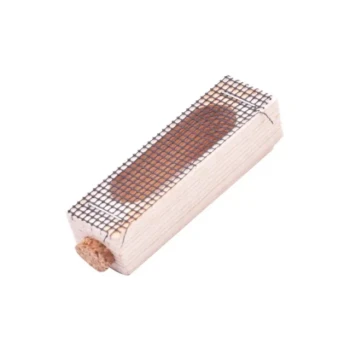At its core, requeening is the single most powerful intervention a beekeeper can make. Replacing an old or failing queen with a young, healthy one revitalizes the entire colony by boosting population growth, improving hive morale, and enhancing overall productivity. A young queen lays eggs more prolifically and secretes higher levels of critical pheromones that stimulate workers, suppress swarming, and help prevent disease outbreaks.
Requeening is a strategic decision to control the genetics and vitality of your colony. It's less about replacing a single bee and more about resetting the hive's potential for productivity, temperament, and health for the coming year.

Why a Young Queen Fundamentally Changes a Colony
A honey bee colony is a superorganism, and the queen is its central reproductive and chemical signaling hub. Her age and quality directly dictate the colony's success or failure.
The Engine of Population Growth
A young queen, typically in her first year, is at her peak reproductive capacity. She can lay up to 2,000 eggs per day.
This prolific egg-laying ensures a constant supply of new worker bees. A larger workforce means more bees to forage for nectar, gather pollen, and defend the hive.
An aging queen's egg-laying rate naturally declines, leading to a dwindling population and a weaker, less productive colony.
The Power of Pheromones
The queen produces a complex scent known as Queen Mandibular Pheromone (QMP). This chemical signal is the social glue of the colony.
A young queen secretes high levels of QMP, which has several direct benefits. It stimulates foraging behavior in workers and helps maintain colony cohesion.
Crucially, strong QMP levels also suppress the swarming impulse by signaling to the workers that their queen is healthy and vital. It also inhibits workers from developing their own ovaries.
The Genetic Blueprint of the Hive
Requeening gives the beekeeper direct control over the colony's genetics. The queen provides half of the genetic material for every worker bee.
This allows you to select for desirable traits such as gentleness, making the hive easier and safer to manage.
You can also introduce genetics for hygienic behavior and disease resistance, creating a more resilient colony that is better able to manage threats like Varroa mites and chalkbrood.
Understanding the Trade-offs and Risks
While highly beneficial, requeening is not a zero-risk procedure. A successful outcome requires careful timing and execution.
The Risk of Queen Acceptance
The colony will not always accept a new queen. Workers may see her as an intruder and "ball" her, surrounding her and killing her through overheating.
Proper introduction methods, such as using a queen cage, are essential to allow the colony to acclimate to her scent over several days.
The Temporary Brood Break
When you replace a queen, there is often a short period with no new eggs being laid. This is known as a brood break.
While a brood break can be beneficial for disrupting the pest cycle of Varroa mites, a prolonged one can weaken the colony's population at a critical time, such as just before a major nectar flow.
The Cost and Quality Factor
Sourcing a high-quality, well-mated queen from a reputable breeder comes at a cost.
A poorly mated or low-quality queen can fail prematurely, negating the benefits and forcing you to repeat the process sooner than expected.
Making the Right Choice for Your Goal
Deciding to requeen should be based on a clear objective for your hive. You are not just fixing a problem; you are setting a new direction.
- If your primary focus is maximizing honey production: Requeen annually with a young, prolific queen to ensure the largest possible workforce leading into the main nectar flow.
- If your primary focus is managing aggressive behavior: Requeening with a queen from a documented gentle genetic line is the most effective and permanent solution to calm a hostile hive.
- If your primary focus is mite and disease resistance: Introduce a queen specifically bred for hygienic traits (like Varroa Sensitive Hygiene - VSH) to build a more self-sufficient and resilient colony.
Ultimately, proactive requeening is the cornerstone of modern beekeeping, transforming it from a reactive practice to a strategic management of colony health and success.
Summary Table:
| Key Benefit | Impact on Colony |
|---|---|
| Prolific Egg-Laying | Increases workforce for foraging and hive defense. |
| Strong Queen Pheromones | Suppresses swarming and improves hive morale. |
| Genetic Control | Introduces traits like gentleness and disease resistance. |
| Brood Break | Can disrupt Varroa mite cycles (temporary benefit). |
Ready to elevate your beekeeping operation? A healthy, productive colony starts with the right genetics and management. At HONESTBEE, we supply commercial apiaries and distributors with the high-quality beekeeping supplies and equipment needed for successful requeening and hive maintenance. Contact us today to discuss how our wholesale-focused solutions can support your goals for higher yields and stronger colonies.
Visual Guide

Related Products
- No Grafting Queen Rearing Kit: System for Royal Jelly Production and Queen Rearing
- Jenter Queen Rearing Kit Complete Set for Bee Breeding
- Wood and Mesh Push-In Queen Cage
- Professional Wooden Requeening Frame for Beekeeping
- JZBZ Langstroth Queen Rearing Frame for Beekeeping
People Also Ask
- What should be done once eggs are present in the comb box? A Guide to Maximizing Queen Rearing Success
- What are the stages involved in queen raising? A Guide to Controlled, High-Quality Queen Production
- What are the signs that indicate a colony needs requeening? Protect Your Hive's Health and Productivity
- What is the timeline for queen breeding? A 28-Day Guide from Egg to Laying Queen
- What do queen rearers do with queens that fail to lay on time? The Critical Quality Control Decision













